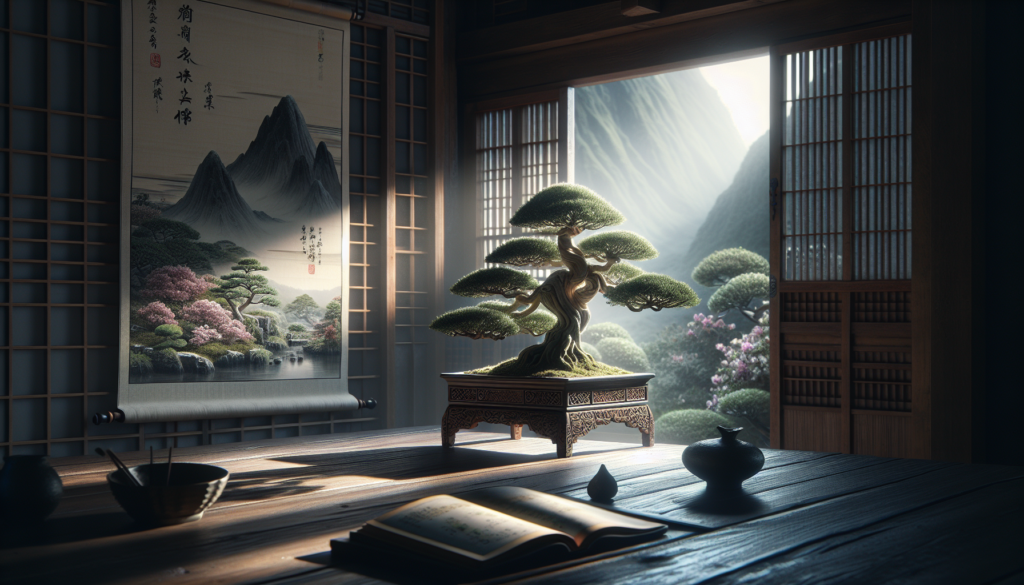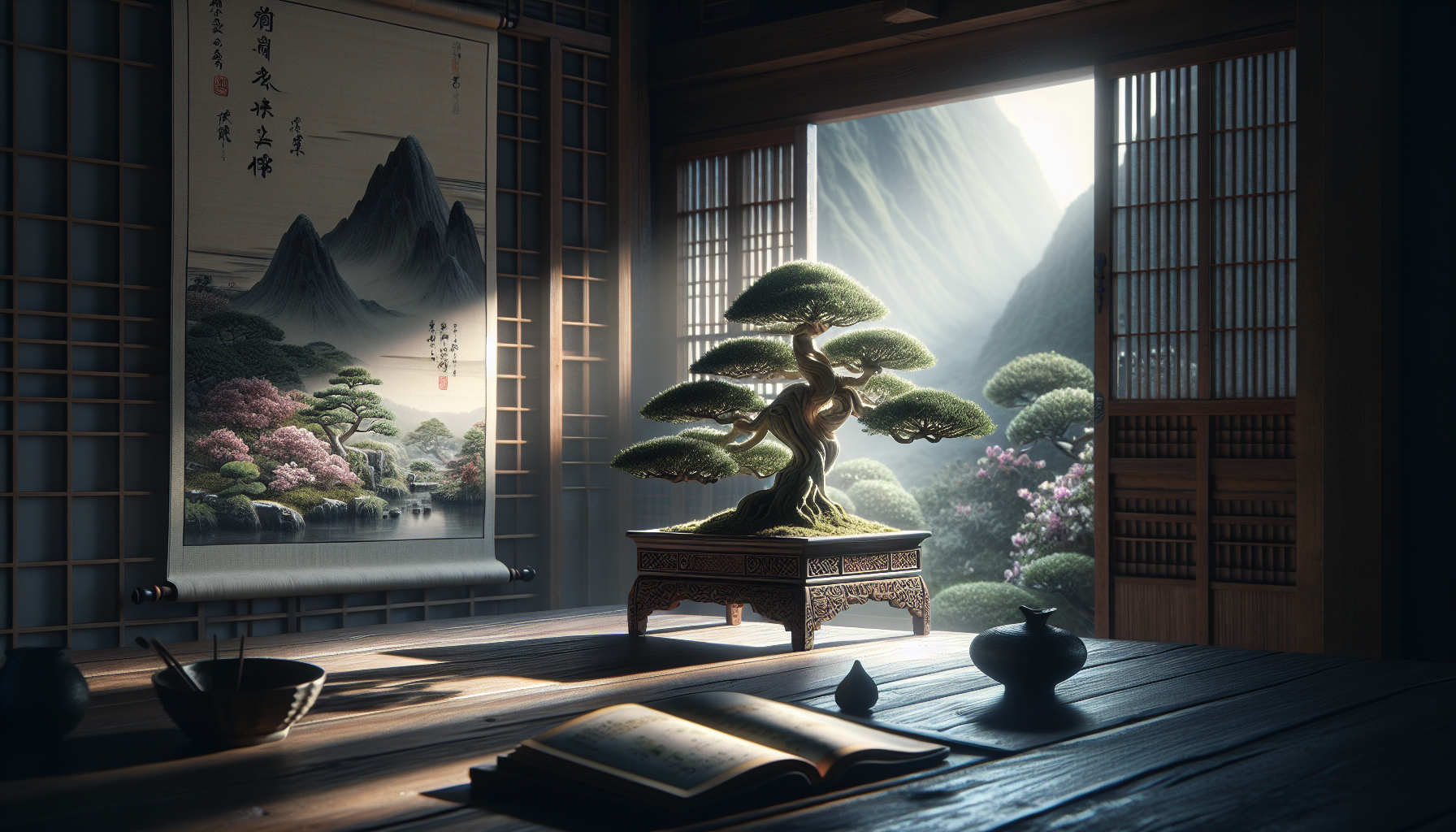Imagine transforming your living space into a tranquil haven of natural harmony with the ancient art of bonsai. The delicate beauty of these miniature trees, carefully pruned and cultivated, can create an atmosphere of serene tranquility that enhances any room. By incorporating bonsai and the principles of feng shui, you can transform your space into a sanctuary of balance and peace. Discover the captivating world of bonsai and learn how it can bring a touch of nature’s artistry into your everyday life.

Understanding the Art of Bonsai
bonsai is an ancient art form that originated in China over a thousand years ago and has since gained popularity across the globe. This horticultural practice involves cultivating and shaping miniature trees to create beautiful, natural-looking replicas of full-sized trees. The word “Bonsai” itself means “planted in a container” in Japanese, highlighting the essence of this art form.
Origin and History of Bonsai
Although Bonsai is often associated with Japanese culture, its roots can be traced back to ancient China. It is believed that the art of Bonsai was first developed during the Tang Dynasty (618-907 AD), where small potted trees were grown as decorations in imperial palaces.
During the Kamakura period (1185-1333 AD), Bonsai traveled from China to Japan, where it was further refined and embraced as a meditative and contemplative practice by Zen Buddhist monks. These monks began to cultivate and care for Bonsai trees as a way to seek enlightenment and engage with nature on a deeper level.
Over time, the art of Bonsai spread beyond the monastic communities and became more accessible to the wider population in Japan. Bonsai cultivation techniques and styles evolved, resulting in unique Japanese approaches and aesthetics.
Fundamental Principles of Bonsai
At the core of Bonsai lies a set of fundamental principles that guide the creation and maintenance of these miniature trees. These principles include proportion, balance, harmony, and naturalness.
Proportion refers to the relationship between the different elements of a Bonsai tree, such as the trunk, branches, and foliage. It is essential to maintain a harmonious balance between these elements to create a visually pleasing composition.
Balance is another crucial aspect that ensures a Bonsai tree’s overall stability and harmony. This can be achieved through careful placement of branches and foliage, as well as maintaining a sense of equilibrium in the tree’s overall design.
Harmony is the key to creating a Bonsai tree that blends seamlessly with its surroundings. This can be achieved by selecting the right tree species and styling it in a way that complements the environment in which it will be displayed.
Naturalness is highly valued in Bonsai, as it aims to mimic the appearance of full-sized trees in nature. Bonsai artists strive to create trees that look organic and display natural growth patterns, despite their miniature size.
Styles and Shapes in Bonsai
Bonsai trees come in various styles and shapes, each representing a different aspect of nature. Some of the most common styles include formal upright, informal upright, slanting, cascade, and semi-cascade.
Formal upright style, known as “Chokkan” in Japanese, features a straight and tapering trunk with branches that gradually decrease in size as they ascend the tree. This style represents strength and stability.
Conversely, the informal upright style, known as “Moyogi,” showcases a more natural and asymmetrical trunk shape, similar to the irregular growth patterns seen in nature. This style often creates a sense of movement and dynamism.
The slanting style, known as “Shakan,” is characterized by a trunk that grows at an angle, conveying the image of a tree enduring strong winds or gravity. This style can evoke a sense of resilience and adaptability.
The cascade style, known as “Kengai,” mimics the appearance of a tree growing on the side of a cliff or a mountain. The trunk cascades downward, creating an elegant and dramatic effect.
Lastly, the semi-cascade style, known as “Han-Kengai,” features a trunk that extends diagonally but doesn’t droop as dramatically as the cascade style. This style is often associated with trees growing on rocky slopes.
Each style and shape in Bonsai carries a unique aesthetic and represents different aspects of nature, allowing enthusiasts to express their personal preferences and bring their artistic vision to life.

The Spiritual Aspect of Bonsai Creation
Beyond its physical and aesthetic appeal, Bonsai encompasses a spiritual aspect that captivates both creators and viewers. The process of cultivating a Bonsai tree demands patience, mindfulness, and a deep connection with nature.
Bonsai creation can be seen as a form of meditation, enabling individuals to enter a state of tranquility and focus. As Bonsai artists carefully shape and care for their trees, they become immersed in the present moment, letting go of distractions and cultivating a sense of inner calm.
This meditative aspect of Bonsai aligns with the principles of Zen Buddhism and reflects the belief in finding beauty in simplicity and stillness. By engaging with Bonsai, enthusiasts can cultivate a deeper appreciation for nature’s beauty and develop a greater sense of harmony within themselves.
Bonsai and Feng Shui
What is Feng Shui?
Feng Shui, a traditional Chinese practice, aims to harmonize individuals with their environment to promote positive energy flow, or “Chi.” This practice draws from concepts of yin and yang, as well as the five elements (wood, fire, earth, metal, and water), to create a balanced and harmonious living space.
Harmonizing Your Space with Bonsai
In the realm of Feng Shui, Bonsai trees hold a special significance. Their connection to nature and their ability to evoke tranquility and harmony make them excellent additions to any living or working space.
Placing a Bonsai tree strategically in your home or workplace can create a sense of tranquility and balance. The presence of a Bonsai tree brings the vitality and life force of nature indoors, enhancing the overall energy of the space.
Feng Shui Aspects to Consider When Placing a Bonsai
When utilizing Bonsai in Feng Shui, certain aspects should be considered when deciding on the placement of your tree. Each direction or sector of a space is associated with specific elements and qualities, which should be taken into account for optimal energy flow.
For example, the east and southeast sectors are associated with the wood element, making them ideal places to display a Bonsai tree. The wood element is linked to growth, abundance, and vitality, qualities that can be enhanced by the presence of a thriving Bonsai.
On the other hand, it is advisable to avoid placing Bonsai trees in areas associated with the fire element, such as the south sector. Fire represents passion and energy, which may clash with the peaceful and calming nature of a Bonsai tree.
Bonsai, Feng Shui, and the Flow of Chi Energy
According to Feng Shui principles, the placement of a Bonsai tree can affect the flow of chi energy in a space. Chi energy should be able to circulate freely and smoothly, promoting a sense of balance and well-being.
The gentle and serene presence of a Bonsai tree can act as a focal point, attracting and channeling positive chi energy. By selecting the right species and placing your Bonsai strategically in your living or working space, you can encourage the flow of positive energy, promoting a sense of harmony and well-being.
Bonsai and Feng Shui can work together to create a space that is not only aesthetically pleasing but also energizing and revitalizing, enhancing both the physical and spiritual aspects of your environment.








